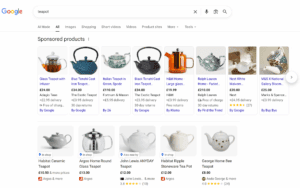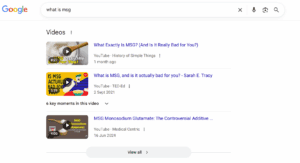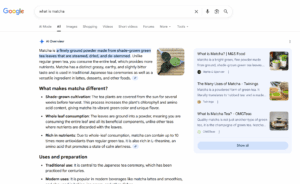
Dynamic SERPs: Understanding and adapting to search

These days, your business could rank in position 1 of Google’s search results and still appear way below the fold. Thanks to dynamic SERPs (search engine results pages), traditional ‘blue link’ search results can appear way down the page below AI-powered, local, or shopping results, and more. Google is constantly changing and developing new ways to show the searcher exactly what it is they’re searching for, often without the need to click.
In this blog, we explain what dynamic SERPs are, what they might look like and how to adapt your SEO efforts to appear in these all-important top-of-the-page search results for your customers.
What are dynamic SERPs?
Dynamic SERPs are personalised, interactive search results designed to fulfil the searchers needs based on Google’s interpretation of the intent of their search query. It can change what a user sees when they search for a term based on their:
- Location – The geographical location of the search can affect what results are displayed for each user, particularly if the search was for something local (e.g.: ‘restaurants near me’).
- Previous searches – Google analyses a user’s previous search history to personalise the search results.
- Device – Mobile SERPs are more likely to appear due to mobile-first indexing, which means Google prioritises the mobile versions of content for rankings and indexing. According to SQ Magazine, 71% of global searches are on mobile devices.
- Search term – As mentioned above, Google uses its algorithm to decide the intent of a search query, providing the searcher with the most relevant type of results.
Google’s transition to Dynamic SERPs
Over the last 20 years or so, Google has been introducing a variety of different dynamic elements within the search results to show the user more useful, visually appealing results, instead of just the classic ‘10 blue links’ of yesteryear.
Whilst the top 10 blue links still appear, they’re surrounded by rich results like local packs, video results, shopping listings and more, meaning the blue links are taking more of a backseat compared to those dynamic search results. The dynamic search elements are designed to draw your attention to what you might find most useful, based on the variables discussed above.
Dynamic SERPs have led to a rise in what’s known as zero click searches, where a user has no need to click through to a website to find the information they’re looking for.
Examples of Dynamic SERP features
Over the years, Google has introduced an array of dynamic SERP features to enhance the user journey, with the most common listed below:
Local packs

When a user is searching for a local result (eg: ‘joiners near me’) or for a term Google deems to warrant a local result (eg: ‘hairdressers’), a Local Pack is usually shown within the search results, giving top-level contact and location details about the three most relevant businesses for the search, including a map with a pin for each.
The businesses displayed are based on their distance from the searcher, the relevance to the search term and also their online visibility.
Featured snippets
Often referred to as ‘position zero’, featured snippets are short, sharp answers in large text appearing in a box at the top of the search results. They can also be displayed as lists or tables, whichever layout gives the best answer for the search term. According to Amra & Elma, featured snippets appear in 19.2% of search results as of 2025, and can increase Click-Through Rate by up to 8% vs standard organic results.
Shopping results

If the user searches for a product that can be purchased online, they are shown shopping listings that can include product images, prices, reviews, site links and even delivery information. Users can be shown both organic (free) and paid (sponsored) shopping listings, as shown in the example below.
Knowledge panels
Introduced in 2012, knowledge panels show a summary of important information about a thing, business, person or place in a box to draw the searcher’s attention. The information is sourced from Knowledge Graph, which initiated Google’s entity-based understanding.
Top stories
For searches around trending topics, Google will display the latest news links to give the user the most recent information around the topic of their search.
Video carousels

If relevant video content exists for a search, Google will display a horizontal or vertical list of helpful videos for the user to browse, generally displayed as thumbnails. The videos appearing in these page 1 carousels will usually be optimised using video SEO, which involves using a video transcript and captions, optimising for mobile devices, ensuring metadata is optimised, and more.
People Also Ask (PAA)

This presents the user with a list of questions related to the original search inside a box, providing the answer and a source link for more information. Answers are often short and direct, in the same way as featured snippets. Clicking on a question adds further related questions for the user, based on the search intent behind the term searched for and common search trends.
Rich snippets
Sometimes simply called ‘rich results’, these search results show extra detail or information for a user beyond the standard ‘blue link’ result, such as star ratings, prices or images. Using structured data markup, website owners can pull through relevant details such as cooking times or calories for a recipe, a product’s availability, price or star rating, or an event date and time, and even the event speakers.
AI Overview

The AI Overview has recently taken precedence over all other search results when it comes to the majority of informational queries as it will always appear at the top of the SERP, pushing those ‘blue link’ results further down the page.
Google uses generative AI to pull together the top level information needed to answer the query, whilst still giving links to sources but allowing the searcher to find the information they need without clicking through multiple sites.
In a study conducted by SurferSEO this year, around 52% of the sources mentioned in AI Overview results rank in the top 10 for that search query, so it’s still important to aim for those page 1 blue link positions.
Whilst useful, the AI Overview answers are not always deemed reliable, but Google continues to improve the technology through machine learning.
According to a study by SEMRush, AI Overviews are on the up, with 13.14% of all search queries triggering an AI Overview in March 2025 – more than double the percentage in January 2025.
How do dynamic SERPs impact your SEO strategy?
Dynamic SERPs can have a number of impacts on your SEO efforts and how your site performs.
Traditional ‘blue link’ listings now have a lower Click-Through Rate (CTR)
The majority (if not all) of the dynamic SERP elements provide the searcher with the answer they’re looking for without the need to click through to the website it appears on.
These more visual results also stand out above the standard organic listings to get the user to their answer more quickly, and provide further reading should it be needed through People Also Ask results. This therefore, impacts Click-Through Rate on the standard top ten positions as the users are more likely to find the answer they need and leave without clicking through.
With the emergence of dynamic SERPs, it’s now more essential to position yourself or your business as an expert in your field and have Google believe it too, in order to show up in those featured snippets and AI overviews. It’s not just about being in position 1 any more, you need to prove your content is the most accurate and most reliable to push it out of the traditional top 10 and into the dynamic SERPs.
It’s also imperative to understand user intent properly in order to answer search queries as the searcher would expect, from getting your local SEO right so you appear in those local or ‘map packs’, to understanding your customers’ pain points and what they might ask next to make it into People Also Ask. Google will only add your website into the mix if it thinks you’re answering that query correctly and via the most helpful medium.
It can broaden your visibility
Brands can appear in multiple modules for the same search term if they put in the leg work, for example, by securing an organic listing, appearing in the video carousel through creating tailored video content, and also appearing in the local pack. This puts your brand in front of your target audience’s eyes in various places throughout the same SERP, improving brand awareness and building up trust and recognition for your business over time.
Dynamic SERPs can enhance conversion paths
Some SERP features allow for direct engagement. For example, shopping results link straight to the product without the need for navigation around the site, while local packs provide telephone numbers or directions to get directly in touch with your business, shortening the conversion funnel.
How to adapt to dynamic search results
It’s important to factor these new visual elements into your strategy to help keep up with your competitors and ensure you’re still showing up for your potential customers. To compete for space amongst your competitors in the dynamic SERPs, you should:
Diversify your content
Create different types of content to suit the query. For example, with How-to guides, a step-by-step breakdown using video content might be the best way to achieve that visibility.
Strengthen your Local SEO
Ensure your business details are correct and consistent across the web. Start with your Google Business Profile and your own website, then check any online directories or listings you may have created.
Having consistent contact details builds trust and authority for your business and will make it more likely you’ll be shown within those standout local packs in the SERPs. If you’re a local business, Local SEO is even more important to help boost your brand.
Add structured data (or ‘schema’)
Using structured data to mark up your products, images and videos allows you to show extra information in the SERPs, such as star ratings, pricing and more to enhance your listing in the search results and help you stand out from the crowd. Schema also helps Google understand what your pages are about so they can pull out the relevant information.
Review the SERPs
It’s important to review the SERPs for your target keywords to see what’s working well and which dynamic search elements are being shown, and also to understand where your brand currently stands within both the dynamic search elements and the traditional results. Using tools such as Google Search Console and ahrefs can help you with this.
Help Google trust your content
From providing author details on blog posts to giving expert opinions and first-hand reviews, it’s important you’re adding elements that prove your experts are, first and foremost, humans with real-life opinions and experiences, and secondly, authorities in your field.
By adding those author details and even linking through to a LinkedIn profile, you’re providing proof that real people with knowledge and expertise are writing your content and giving Google the signs it needs to trust in your content and push it forward for searchers.
It’s also important to provide social proof that your business can be trusted, whether that’s through customer reviews or case studies on your website. These social signals help prove to Google (and also customers) that your brand is real and can be trusted to do a good job, and therefore boosts your visibility.
Ensure your site is technically sound
Technical SEO still holds so much value with Google when it comes to rankings and dynamic SERP features. Ensuring your website loads quickly and is easy to navigate could mean you’re more likely to appear on page 1, whether that’s in traditional results or the dynamic search results we’ve been discussing.
Reach your dynamic SERP potential
Many brands and businesses still view Google as a list of links to be clicked, when the reality is much different. It’s a layered experience tailored to each user based on location, their search query, their search history and the device they’re searching on. It’s time to catch up with your competitors in an ever-changing SERP landscape.
Working with the right digital marketing agency can help you achieve your page 1 dynamic SERP goals. Get in touch with the team at Embryo today to get started on your SEO journey.


